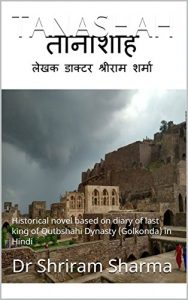About the Book:
It was a chance interaction of the author with a vendor near Daulatabad Fort, Aurangabad, Maharashtra, India. Author got curious by looking at a paper being used by vendor for packing his product while selling to customers. Due to author’s inquisitiveness after reading text written on paper, author persuaded and obtained bundles of such papers from the vendor. Later on closer scrutiny by author it turned out to be diary of last Qutbshahi Dynasty king who was imprisoned in Daulatabad Fort by Mughal emperor Aurangzheb. Author has written this interesting novel on the basis of diary of last king Abul Hasan Tanashah of Qutbshahi Dynasty of Golkonda (old Hyderabad, India). This historical novel depicts the culture, trade and commerce as well as social & political scenario of Golkonda and southern India during the days of Mughal empire about 300 years ago. Various expeditions of Mughals to conquer Golkonda and other southern kingdoms is vividly described. This historical novel highlights internal conflicts in the ruling dynasties and between different kings / chieftains which makes it very interesting.
About the Author:
Dr Shri Ram Sharma was an eminent scholar and Professor of Hindi at Osmania University, Hyderabad, India. He has authored around thirty books and written over 500 articles on various subjects such as Linguistics (specially origin & growth of Dakhini language), Hindi & Urdu literature, Sociology (Banjara Tribe) and Historical novels. He was prolific writer and regularly contributed to leading national newspapers & magazines in India and abroad. Many scholars from India and overseas were guided by him for their Ph. D research work. He actively participated in various cultural and social forums and promoted many budding authors, poets and artists.
He has written some interesting historical novels after living through a part of history himself by being a freedom fighter and spending some time as political prisoner due to taking active part in freedom struggle to liberate Hyderabad from Nizam’s rule and Razakar movement. In writings of Dr Sharma one notices a realistic description of environment around various characters of this novel in Hindi language. Aurangzheb’s personality as well as tactical and operational strategy of Mughal army is nicely described.
Readers will find this novel interesting and enriching their knowledge about happenings during Mughal empire specially during Aurangzheb’s regime.
Some important literary works in Hindi of the author published by various leading publishers:
Origin and growth of Dakhini language
Prose and poetry of Dakhini language
Literature of Dakhini language
Sanskrit works in Persian (English)
Kailog’s Hindi Grammar
History of Urdu literature (Editor)
Banjara Tribe (Life style and traditions of Banjaras, a nomadic tribe of India)
Banjara Folk songs and literature
Quli Qutbshah’s prose (Editor)
Ghalib’s letters (2 volumes)
Galib Ek Jeevanee, (Autobiography of great Urdu Poet Mirza Ghalib)
Tanashah
Great Icons of South India
Khalik Bari (Editor)
Sabras (Editor)
It was a chance interaction of the author with a vendor near Daulatabad Fort, Aurangabad, Maharashtra, India. Author got curious by looking at a paper being used by vendor for packing his product while selling to customers. Due to author’s inquisitiveness after reading text written on paper, author persuaded and obtained bundles of such papers from the vendor. Later on closer scrutiny by author it turned out to be diary of last Qutbshahi Dynasty king who was imprisoned in Daulatabad Fort by Mughal emperor Aurangzheb. Author has written this interesting novel on the basis of diary of last king Abul Hasan Tanashah of Qutbshahi Dynasty of Golkonda (old Hyderabad, India). This historical novel depicts the culture, trade and commerce as well as social & political scenario of Golkonda and southern India during the days of Mughal empire about 300 years ago. Various expeditions of Mughals to conquer Golkonda and other southern kingdoms is vividly described. This historical novel highlights internal conflicts in the ruling dynasties and between different kings / chieftains which makes it very interesting.
About the Author:
Dr Shri Ram Sharma was an eminent scholar and Professor of Hindi at Osmania University, Hyderabad, India. He has authored around thirty books and written over 500 articles on various subjects such as Linguistics (specially origin & growth of Dakhini language), Hindi & Urdu literature, Sociology (Banjara Tribe) and Historical novels. He was prolific writer and regularly contributed to leading national newspapers & magazines in India and abroad. Many scholars from India and overseas were guided by him for their Ph. D research work. He actively participated in various cultural and social forums and promoted many budding authors, poets and artists.
He has written some interesting historical novels after living through a part of history himself by being a freedom fighter and spending some time as political prisoner due to taking active part in freedom struggle to liberate Hyderabad from Nizam’s rule and Razakar movement. In writings of Dr Sharma one notices a realistic description of environment around various characters of this novel in Hindi language. Aurangzheb’s personality as well as tactical and operational strategy of Mughal army is nicely described.
Readers will find this novel interesting and enriching their knowledge about happenings during Mughal empire specially during Aurangzheb’s regime.
Some important literary works in Hindi of the author published by various leading publishers:
Origin and growth of Dakhini language
Prose and poetry of Dakhini language
Literature of Dakhini language
Sanskrit works in Persian (English)
Kailog’s Hindi Grammar
History of Urdu literature (Editor)
Banjara Tribe (Life style and traditions of Banjaras, a nomadic tribe of India)
Banjara Folk songs and literature
Quli Qutbshah’s prose (Editor)
Ghalib’s letters (2 volumes)
Galib Ek Jeevanee, (Autobiography of great Urdu Poet Mirza Ghalib)
Tanashah
Great Icons of South India
Khalik Bari (Editor)
Sabras (Editor)












